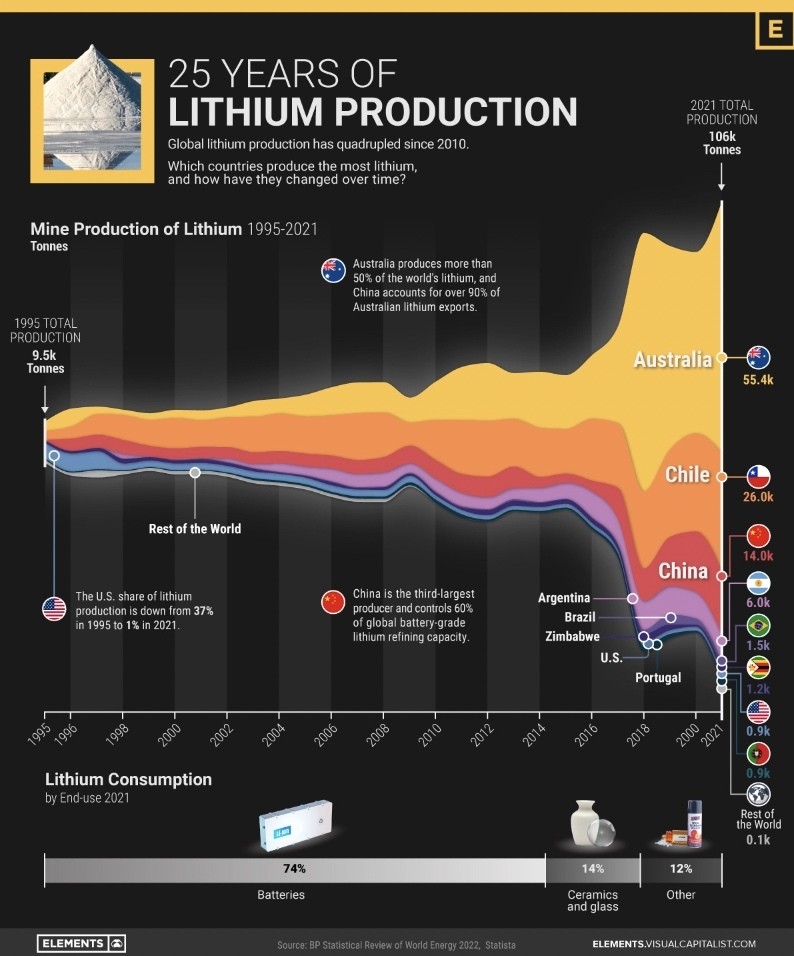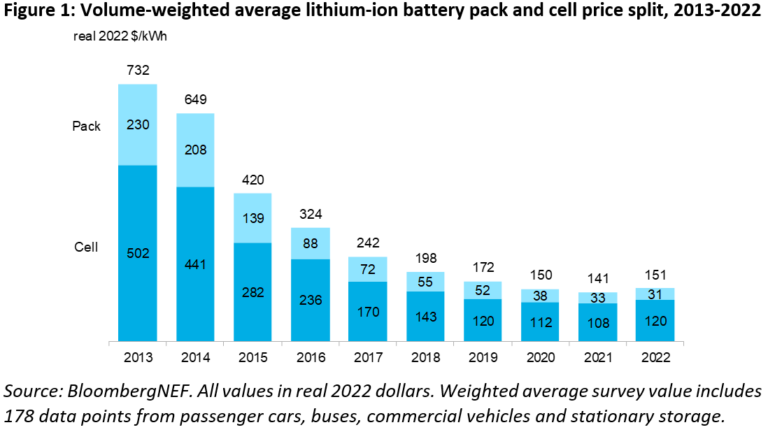The best of times.
Battery technology has made huge advances in a relatively short amount of time. When batteries started being commercially produced in the early 1900s, lead acid or “wet cell” batteries were the only option. “Dry cell” batteries were made too, but they were for small applications such as flashlights. If you needed big current, you had to get wet. Today, lithium batteries are everywhere. It’s not an overstatement to say lithium batteries have changed the world the same way transistors did back in the 1950s and 1960s.
Searching for something better.
Nickel cadmium (NiCd) batteries should be familiar to older hams. These predecessors to lithium batteries were actually invented in 1899, and Thomas Edison dabbled in them too. But they were not commonly available until much later. Conventional wet and dry cell batteries soldiered along until around the 1950s, when rechargeable nickel-cadmium batteries were advanced enough for consumer use. NiCd batteries have a few flaws, not the least of which is they contain cadmium, which is a toxic heavy metal. Today, nickel cadmium batteries are essentially extinct, having been relegated as obsolete by other technologies and environmental regulations related to their cadmium content. In 2006 nickel cadmium batteries were banned in the European Union except for a few specialty applications. They are not banned in the USA but since they are so seldom used it doesn’t really matter.
Lithium batteries have a much shorter history. Research into lithium batteries dates back to the 1960s in the NASA space program. The research did not go very far until the mid 1970s when scientist M. Stanley Whittington developed a working prototype. From there, Exxon (the petroleum company) took over the idea but could not come up with a product that was safe and cost effective.
The next steps.
Beginning in 1980, other scientists developed a cobalt oxide version of the lithium battery. It was promising but there were serious safety concerns. The main problem was the instability of lithium, which can easily catch fire. The advances continued throughout the 1980s. In the 1990s, a team of Canadian scientists improved energy density, placing lithium batteries in the nascent stages of widespread use. The implementation started will very small applications such as watches and calculators. Batteries big enough for ham equipment were still a few years away.
There are a lot of names associated with the development of the lithium battery, way more than can be covered in one short article. However, M. Stanley Whittington could plausibly be considered the “grandfather” of lithium batteries and was a co-winner of a Nobel Prize in chemistry in 2019 for his contribution. As of this writing, Whittington is still alive and working as a college professor in New York (SUNY Binghamton).
The iPhone effect.
It’s not out of reason to postulate that the introduction of the iPhone in 2007 “broke the dam” for lithium batteries. It’s also noteable that the iPhone would not exist, at least not in its current form, but for the development of the lithium battery. Those of you old enough to know what a “brick phone” is (which is not the same as a bricked phone) can truly relate. The early brick phones got their name because of their large, clunky batteries. The lithium battery was small enough to fit in a pocket yet powerful enough to push a processor and display. This convergence of technology is what made smartphones possible, and more importantly, encouraged the mass adoption of lithium batteries.
The Tesla effect.
If the iPhone broke the dam, then the Tesla automobile was the water rushing in. The ascendancy of electric cars created economies of scale needed to make large lithium batteries affordable. For the first time, lithium batteries with enough capacity to run amateur radio equipment and off grid systems were within reach of the average ham.
The graph below shows worldwide lithium production from 1995 to 2021. While it is not directly indicative of battery production, it does closely parallel. Notice how lithium production modestly increased during the early 2000s, then briefly dipped around 2008 (which might be due to the economic downturn at the time). Around 2010 is a bump, and beginning in 2016 lithium production absolutely takes off. These increases correlate with the market penetration of electric cars and other battery operated products such as power tools. The latest worldwide lithium production data I can find is from 2023, with 184,000 metric tons. Compare that to the chart when just two years ago 106,000 metric tons were mined. According to the World Economic Forum, as of 2021 74% of all mined lithium was used for batteries.
Australia, the king maker.
As anyone who even loosely follows this topic would know, a large majority of lithium batteries are made in Asia, particularly China. That’s only part of the story. While Asia makes the most batteries, Australia produces the most lithium, about half of it to be exact. China accounts for only 13% of worldwide lithium mining. The path to ending the United States’ dependence on Asia for lithium batteries runs straight through Australia! Australia is a stable democracy and very strong ally of the United States. The geopolitical and economic minutiae of such a deal are far beyond the mission of this blog but I don’t think it would be hard to convince the Australians to send their lithium ore to the USA, if there was a market for it.
What this means for off grid hams.
It’s unlikely we’ll have to wait over 100 years for the next big leap in battery technology, but the research is not blindingly fast, either. Any major advancements will probably not trickle down to radio amateurs for many years, possibly a decade or more. For the foreseeable future, lithium is going to be our best option. What is more likely is for prices to continue dropping. One hundred amp-hour lithium batteries that used to cost over $1000 can be found for around $800 and many are under $500. Hams who wanted to go with lithium but could not due to budget reasons now have many reasonably priced choices.
Another plus is that the chargers needed for lithium batteries are getting less expensive and easier to find. The economic argument in favor of conventional wet cell and sealed lead acid batteries is becoming less and less persuasive. In a strange twist of market dynamics, the price has gone down even though demand has gone up dramatically.
Of course we should be looking for the next “Big Thing”, but heck, it took decades for lithium batteries to become affordable and accessible. They are going to be around for a while, so, let’s enjoy the ride.



Amazing how quickly things can change sometimes. That was very interesting. I had no idea about the long history of lithium batteries. Just in the last year or so the price of my 5 kwh batteries dropped from $1,700 to $1,100.
right now my solar power system hasn’t been doing my much good except as an emergency backup system. We’ve had almost non stop thunderstorms and rain for days and days now. It’s been pounding down rain since I got up at 6 AM and from what they just said on the radio it’s going to be like this all day. The sump pumps down in the basement have been running almost nonstop for days now. Parts of this house are over 100 years old and I’m sure there’s going to be water seeping through the old foundation walls when I get in the basement and I’ll have to fire up the dehumidifier, floor fans and probably wetvac the floor. We love this house but it does have it’s “quirks”, as they say.
Thanks Chris. Good article as usual!
Hey there Randy, I held off moving my home system to lithium due to the cost. But my current wet cell batteries are overdue for replacement, so this may be the perfect opportunity to upgrade. Unfortunately I’d have to upgrade my charge controller too, so even with all the good deals out there it would be a big ticket expense.
Your situation with the constant rain is a good lesson in having a “plan B”. As great as solar is, it’s only as good as the weather. Hmmmm that might make a good topic for a future article.
As always it’s good to hear from you.
That upfront cost is still pretty steep even with prices coming down. My 30 kwh battery bank would still cost about $6,000 – $7,000 even with the price drops over the last year or so. That’s still way too much for most people to be able to absorb in their family budget. Most solar systems that I see being installed these days are grid-tied with no batteries at all. A/ll they do is cover the house’s daytime electrical usage and hopefully produce enough excess to get credits from the utility company to offset their cost when they have to buy power from the grid. The problem with that is that there is now an excess of solar generation during peak production times when the utility companies don’t need the power which is playing havoc with the entire electrical grid and pricing system. I’ve heard of situations where not only does the utility company not want your power, can’t use it, and will actually charge you for every kwh you pump into the grid. It’s crazy out there right now.
An article about a Plan B is an excellent idea! I can go for days, even weeks, without enough sunlight here to get a significant amount of power out of my solar panels. In my case I have an EG4 Chargeverter wired into the busbars of my battery bank which gets tied to an outside 7.5 KW gasoline generator. So if I have to I can keep the batteries charged with that. Noisy, expensive, smelly, but it works.
Pingback: Amateur Radio Weekly – Issue 337 • AmateurRadio.com